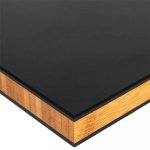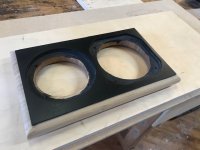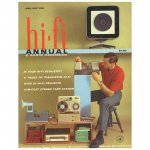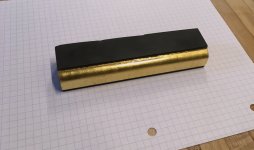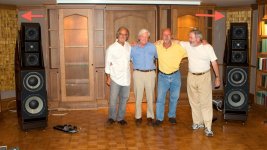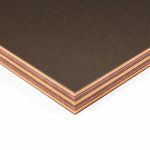he PlyBoo bamboo plywood core, which is .75-in furniture quality vertical fillets with black Richlite 1/8ths cladding front and back
Is “vertical fillets” = “block core”? If so instead of a bamboo veneer, it uses Richlite. Be interesting to compare to the stranded bamboo, the difference then bein the outer veneer layers.
dave
I am not sure what "block core" is, but here's a photo. I have samples of PlyBoo, and the Richlite appears to be PlyBoo with Richlite "veneers."
I assume that there is some benevolent constrained-layer damping going on. Also, the Richlite machines beautifully with tight tolerances, and if you invest the work in it, you can have a suede or satin finish that is really nice.
But for me the biggest benefit is that is just SCREAMS, "This is not MDF!"
Here's a link to lots of instructional videos: https://www.ecosupplycenter.com/products/richlite/video-gallery/
ciao,
john
I assume that there is some benevolent constrained-layer damping going on. Also, the Richlite machines beautifully with tight tolerances, and if you invest the work in it, you can have a suede or satin finish that is really nice.
But for me the biggest benefit is that is just SCREAMS, "This is not MDF!"
Here's a link to lots of instructional videos: https://www.ecosupplycenter.com/products/richlite/video-gallery/
ciao,
john
Attachments
That looks like block core Plyboo. 👍 Dave and I have both used it for speaker cabs, it's great stuff. But I don't remember ever seeing it coated like that. Must be new?
Also, is the phenolic resin ply the same stuff used in the floor of shipping containers? That material seems very nice.
Also, is the phenolic resin ply the same stuff used in the floor of shipping containers? That material seems very nice.
Plyboo Srand for comparison.
6.Physical/MechanicalProperties:
a/ STMD3043MethodDFlexuralStrength(MOE/MOR)
¾inchthick,3-ply,CrossCoreStrand:268MOE/14,760MOR
b/ STMD1037ScrewHold
¾inchthick,3-ply,CrossCoreStrand
Face:742pounds
Back:831pounds
Edge1:980pounds
Edge2:759pounds
c/ ASTMD4442MethodAMoistureContent
¾inchthick,3-ply,CrossCoreStrand:average6-9percent
d/ ASTMD1037TensileStrengthParallel
¾inchthick,3-ply,CrossCoreStrand:Load1732pounds,
Strength5968psi
e/ ASTMD3500TensileStrengthPerpendicular
¾inchthick,3-ply,CrossCoreStrand:
Load1591pounds, Strength1061psi
dave
6.Physical/MechanicalProperties:
a/ STMD3043MethodDFlexuralStrength(MOE/MOR)
¾inchthick,3-ply,CrossCoreStrand:268MOE/14,760MOR
b/ STMD1037ScrewHold
¾inchthick,3-ply,CrossCoreStrand
Face:742pounds
Back:831pounds
Edge1:980pounds
Edge2:759pounds
c/ ASTMD4442MethodAMoistureContent
¾inchthick,3-ply,CrossCoreStrand:average6-9percent
d/ ASTMD1037TensileStrengthParallel
¾inchthick,3-ply,CrossCoreStrand:Load1732pounds,
Strength5968psi
e/ ASTMD3500TensileStrengthPerpendicular
¾inchthick,3-ply,CrossCoreStrand:
Load1591pounds, Strength1061psi
dave
Hi!That looks like block core Plyboo. 👍 Dave and I have both used it for speaker cabs, it's great stuff. But I don't remember ever seeing it coated like that. Must be new?
Also, is the phenolic resin ply the same stuff used in the floor of shipping containers? That material seems very nice.
I don't believe that it is new... that is the reason that I titled this thread "An Under-Appreciated... ." I enjoy sharing what I have learned.
AFAIK, Richlite products are the real top end of that family of materials. They formerly had up a brag sheet of places where Richlite has been used in fabricating interior installations and partition walls and food-prep areas, and that list started with Yale. So, I assume that Richlite's birch plywood composite is way too expensive for shipping containers. Their bamboo composite is furniture-quantity. I dug up a shot of my Roxy Deluxe front panel before it got all the violin varnish. The short sides have the nice ply reveal that I think would look very cool on the front of a turntable.
ciao,
john
Attachments
Hi--I really appreciate your interest!Yes, that ia block core. Is there engineering data on the richlite?
dave
There are many many technical documents, including ASTM E90 04 Sound Transmission for two thicknesses:
https://www.ecosupplycenter.com/products/richlite/#technical-docs
My anecdotal experience is that it is a very nice material for front baffles. But honestly, I try to design loudspeakers with market appeal, and that is more than half the battle for me.
My next design will have a stacked-plywood cabinet shell (the front panel will show the striations), and with Richlite Birch Stratum sides, for more of a Mid-Century-Modern look.
BTW, speaking of MCM, I was once working for a client who had a hoity-toity industrial design firm on the payroll. The client showed me the ID firm's idea for a loudspeaker cabinet, which looked strangely familiar. Bingo. It was an "homage" to the Charles Eames loudspeaker of the 1950s (smaller in scale, of course). I dug up the Eames patent and emailed it to the client.
tee hee,
john
Attachments
I don't believe that it is new...
Many of the 50-70 year old consoles i have dissembled used (cheap) block core for construction
I would really like th eopportunity to make my own plywood out of the stranded veneer, is richlite available as a veneer?If so how thick.
dave
stacked-plywood
Translam. It does allow some things, but overall it is wasteful, needs more net material since you are not using the materials in the direction they were intended so need to be thicker.
A brute force approach.
dave
Hi-Many of the 50-70 year old consoles i have dissembled used (cheap) block core for construction
I would really like th eopportunity to make my own plywood out of the stranded veneer, is richlite available as a veneer?If so how thick.
dave
What I meant was that the Richlite product that laminates solid Richlite onto bamboo plywood was not new, but on the other hand I dunno if it is that old.
Richlite has small sample cuts in stock, but the thinnest is .25-inch.
I can ask tmw if they sell .125. They usually deal in 4 x 8 foot sheets, and it seems to me that a .125 sheet would be hard to handle.
https://www.richlite.com/collections/partial-sheets/products/partial-sheets-slate
jm
Thanx for the links. I hate doc files, but here is the equivakebt section of one of those:
1.1. MATERIALS
A. Paper Composite Sheets: Cellulose or hemp-fiber paper heat pressed with phenolic resin; color consistent throughout thickness.
1. Surface Burning Characteristics: Flame spread 30, maximum; smoke developed 30, maximum; when tested in accordance with ASTM E 84.
2. Density: 75.84 pounds per cu ft (1215 kg per cu m).
3. Water Absorption: 0.36 percent for 1 inch (25 mm) thickness, unsealed material, 24 hour fully submerged test.
4. Specific Gravity: 1.213.
5. Thermal Properties:
a. Coefficient of Thermal Expansion, X Direction: 5.2 microinches per inch degree F (9.4 microns per mm degree C).
b. Coefficient of Thermal Expansion, Y Direction: 12.8 microinches per inch degree F (23.0 microns per mm degree C).
c. Coefficient of Thermal Expansion, Z Direction: 45.9 microinches per inch degree F (82.7 microns per mm degree C), for span of 73.5 inches (1.87 m).
d. Thermal Conductivity: 0.00051 Cal cm/sq cm sec degree C.
6. Tensile Strength:
a. X Direction: 19,200 psi (132.4 MPa).
b. Y Direction: 13,100 psi (90.3 MPa).
7. Compressive Strength:
a. X Direction: 18,400 psi (126.9 MPa); 7.09 percent strain at failure.
b. Y Direction: 15,900 psi (109.6 MPa); 7.15 percent strain at failure.
c. Z Direction: 30,000 psi (206.8 MPa); 20 percent strain at failure.
8. Flexural Strength, Face in Tension:
a. X Direction: 22,000 psi (151.7 MPa).
b. Y Direction: 17,300 psi (119.3 MPa).
9. Flexural Strength, Edge in Tension:
a. X Direction: 20,400 psi (140.6 MPa).
b. Y Direction: 16,100 psi (111.0 MPa).
10. 10.Izod Impact, Face Impact:
a. X Direction: 2.48 ft lb per inch of width (0.046 J/m of width).
b. Y Direction: 1.46 ft lb per inch of width (0.027 J/m of width).
11. 11.Izod Impact, Edge Impact:
a. X Direction: 0.68 ft lb per inch of width (0.013 J/m of width).
b. Y Direction: 0.62 ft lb per inch of width (0.012 J/m of width).
1.1. MATERIALS
A. Paper Composite Sheets: Cellulose or hemp-fiber paper heat pressed with phenolic resin; color consistent throughout thickness.
1. Surface Burning Characteristics: Flame spread 30, maximum; smoke developed 30, maximum; when tested in accordance with ASTM E 84.
2. Density: 75.84 pounds per cu ft (1215 kg per cu m).
3. Water Absorption: 0.36 percent for 1 inch (25 mm) thickness, unsealed material, 24 hour fully submerged test.
4. Specific Gravity: 1.213.
5. Thermal Properties:
a. Coefficient of Thermal Expansion, X Direction: 5.2 microinches per inch degree F (9.4 microns per mm degree C).
b. Coefficient of Thermal Expansion, Y Direction: 12.8 microinches per inch degree F (23.0 microns per mm degree C).
c. Coefficient of Thermal Expansion, Z Direction: 45.9 microinches per inch degree F (82.7 microns per mm degree C), for span of 73.5 inches (1.87 m).
d. Thermal Conductivity: 0.00051 Cal cm/sq cm sec degree C.
6. Tensile Strength:
a. X Direction: 19,200 psi (132.4 MPa).
b. Y Direction: 13,100 psi (90.3 MPa).
7. Compressive Strength:
a. X Direction: 18,400 psi (126.9 MPa); 7.09 percent strain at failure.
b. Y Direction: 15,900 psi (109.6 MPa); 7.15 percent strain at failure.
c. Z Direction: 30,000 psi (206.8 MPa); 20 percent strain at failure.
8. Flexural Strength, Face in Tension:
a. X Direction: 22,000 psi (151.7 MPa).
b. Y Direction: 17,300 psi (119.3 MPa).
9. Flexural Strength, Edge in Tension:
a. X Direction: 20,400 psi (140.6 MPa).
b. Y Direction: 16,100 psi (111.0 MPa).
10. 10.Izod Impact, Face Impact:
a. X Direction: 2.48 ft lb per inch of width (0.046 J/m of width).
b. Y Direction: 1.46 ft lb per inch of width (0.027 J/m of width).
11. 11.Izod Impact, Edge Impact:
a. X Direction: 0.68 ft lb per inch of width (0.013 J/m of width).
b. Y Direction: 0.62 ft lb per inch of width (0.012 J/m of width).
MOE/MOR is probably most important, but i think er need an engineer to align the units for comparison.
dave
dave
Before the great "board shortage" and COVID we had our deck changed out from pressure treated to "ipe decking" -- the guys installing it used plugs but had to replace the drill bits after about 4 shots.The only way to machine it was to use tungsten tipped blades.
Richlite says it can be coated with polyurethanes.
Very interesting material for cabinets. I really do like it’s machine ability and the fact, that you can tapper and screw directly into Richlite.
Could this actually be the basis for the much fabled Wilson Audio X material?
Comes with the same characteristics and X is also based on a phenolic and paper composite; often speculated with some Graphite added.
Could this actually be the basis for the much fabled Wilson Audio X material?
Comes with the same characteristics and X is also based on a phenolic and paper composite; often speculated with some Graphite added.
Hi. I am pretty close to Wilson Audio. The photo shows me on the far right, with my arm around Chris Huston, who was a close friend of John Lennon's in art college. Chris' band The Undertakers gave English "Blues Shouter" Jackie Lomax his first gig. Chris later won the Grammy for producing The World Is a Ghetto. The budget for that room was USD$1 million. That said, Wilson Audio keep their composites a secret, so I have never asked. BTW the arrows indicate the diffusion panels I insisted upon--24 such panels transformed the room.
Richlite was developed during WWII to make "drop boxes" to parachute-drop weapons to Partisans behind Nazi lines. It's a very tough material! That said, I think that as a practical matter, the plywood-core materials (bamboo ply or birch ply) with front and back Richlite laminations are easier to work with for loudspeaker boxes, in terms of cutting the material, and the weight of the finished project.
But if you are building a super-speaker with twin 10- or 12-inch woofers, perhaps the Richlite "Rainier" material, 1.25 inches thick, would be a worthy contender to Wilson's proprietary materials. That would make for a lovely edge reveal! (And, weigh a ton. A 4 x 8-foot sheet of Ranier weighs 1,803 pounds!)
BTW, I have to start a new thread--about a joinery machine that should excite some cabinet builders who work in quantities!
amb,
john
Richlite was developed during WWII to make "drop boxes" to parachute-drop weapons to Partisans behind Nazi lines. It's a very tough material! That said, I think that as a practical matter, the plywood-core materials (bamboo ply or birch ply) with front and back Richlite laminations are easier to work with for loudspeaker boxes, in terms of cutting the material, and the weight of the finished project.
But if you are building a super-speaker with twin 10- or 12-inch woofers, perhaps the Richlite "Rainier" material, 1.25 inches thick, would be a worthy contender to Wilson's proprietary materials. That would make for a lovely edge reveal! (And, weigh a ton. A 4 x 8-foot sheet of Ranier weighs 1,803 pounds!)
BTW, I have to start a new thread--about a joinery machine that should excite some cabinet builders who work in quantities!
amb,
john
Attachments
twin 10- or 12-inch woofers
Given that 2 woofers can be arranged push-push, 15mm should be sufficent, no need to fo overkill with 1.25”
dave
Hi, Thanks.Given that 2 woofers can be arranged push-push, 15mm should be sufficent, no need to fo overkill with 1.25”
dave
If by that you mean Isobaric alignment, as described by Olson in the 1950s and used today by Egglestonworks and Wilson Benesch, I get that.
Not to be a Philistine, but I think that the reason isobaric is not used more often is the idea that "The customers are paying for two woofers, and they want their friends to see them!"
It's also a tradeoff, I think, in cabinet construction labor versus materials cost. And again, I think that part of the sales appeal of Wilson Audio's super-speakers is, "Wow! Those speakers weigh 670 pounds!"
ciao,
john
- Home
- Loudspeakers
- Multi-Way
- An Under-Appreciated Cabinet Material
